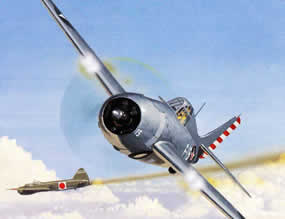 |
 |
Image of F4F Wildcat taken from: http://www.fiddlersgreen.net/models/aircraft/Grumman-Wildcat.html |
F4F Wildcat - Operational History: "Entering service with VF-7 and VF-41 in December 1940, the F4F-3 was equipped with four .50 cal. machine guns mounted in its wings. While production continued for the US Navy, Grumman offered a Wright R-1820 "Cyclone 9"-powered variant of the fighter for export. Ordered by the French, these aircraft were not complete by the fall of France in mid-1940. As a result, the order was taken over by the British who used the aircraft in the Fleet Air Arm under the name "Martlet." Thus it was a Martlet that scored the type's first combat kill when one downed a German Junkers Ju 88 bomber over Scapa Flow on December 25, 1940. Learning from British experiences with the F4F-3, Grumman began introducing a series of changes to the aircraft including folding wings, six machine guns, improved armor, and self-sealing fuel tanks. While these improvements slightly hampered the new F4F-4's performance, they improved pilot survivability and increased the number that could be carried aboard American aircraft carriers. Deliveries of the "Dash Four" began in November 1941. A month earlier, the fighter officially received the name "Wildcat." Information on F4F Wildcat obtained from: http://militaryhistory.about.com/od/worldwariiaircraft/p/f4fwildcat.htm |
USS Nehenta Bay (CVE-74) Service in World War II "In her first operations for the Navy, the USS Nehenta Bay made two trips to Pearl Harbor to transport planes and bring in replacement aircrew. Following her second Pearl Harbor fun, the crew of the USS Nehenta Bay underwent combat readiness training at ports in both California and Hawaii. By June 1944, the USS Nehenta Bay was ready to support U.S. forces fighting in the Far East. After aiding air strike missions in the invasion of Tinian, the USS Nehenta Bay joined the Midway and 12 other destroyers to conduct antisubmarine and air strike patrols in Guam and Saipan. In her next set of missions, the USS Nehenta Bay escorted fleet oilers that needed replenishing and, subsequently, worked with the 3rd Fleet to successfully complete a series of operations from August 1944 to January 1945. The same month these operations ended, the USS Nehenta Bay endured a nasty typhoon, which wrecked some significant damage and caused this vessel to sail back to San Diego for an overhaul, as well as refresher training to prepare for the upcoming Okinawa attack (During Okinawa, the USS Nehenta Bay's planes made direct attacks on enemy targets and valiantly survived a kamikaze attack)." Information on USS Nehenta Bay obtained from: http://www.hullnumber.com/CVE-74 |